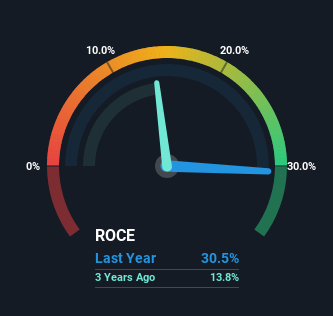
What are the early trends we should look for to identify a stock that could multiply in value over the long term? Firstly, we'll want to see a proven return on capital employed (ROCE) that is increasing, and secondly, an expanding base of capital employed. Ultimately, this demonstrates that it's a business that is reinvesting profits at increasing rates of return. With that in mind, the ROCE of Titan (NSE:TITAN) looks attractive right now, so lets see what the trend of returns can tell us.
Return On Capital Employed (ROCE): What Is It?
For those who don't know, ROCE is a measure of a company's yearly pre-tax profit (its return), relative to the capital employed in the business. Analysts use this formula to calculate it for Titan:
Return on Capital Employed = Earnings Before Interest and Tax (EBIT) ÷ (Total Assets - Current Liabilities)
0.31 = ₹45b ÷ (₹329b - ₹183b) (Based on the trailing twelve months to September 2023).
Thus, Titan has an ROCE of 31%. That's a fantastic return and not only that, it outpaces the average of 10% earned by companies in a similar industry.
See our latest analysis for Titan

Above you can see how the current ROCE for Titan compares to its prior returns on capital, but there's only so much you can tell from the past. If you'd like to see what analysts are forecasting going forward, you should check out our free report for Titan.
The Trend Of ROCE
We'd be pretty happy with returns on capital like Titan. The company has consistently earned 31% for the last five years, and the capital employed within the business has risen 156% in that time. Returns like this are the envy of most businesses and given it has repeatedly reinvested at these rates, that's even better. If Titan can keep this up, we'd be very optimistic about its future.
Another thing to note, Titan has a high ratio of current liabilities to total assets of 55%. This effectively means that suppliers (or short-term creditors) are funding a large portion of the business, so just be aware that this can introduce some elements of risk. While it's not necessarily a bad thing, it can be beneficial if this ratio is lower.
Our Take On Titan's ROCE
In summary, we're delighted to see that Titan has been compounding returns by reinvesting at consistently high rates of return, as these are common traits of a multi-bagger. And long term investors would be thrilled with the 294% return they've received over the last five years. So while the positive underlying trends may be accounted for by investors, we still think this stock is worth looking into further.
If you want to continue researching Titan, you might be interested to know about the 1 warning sign that our analysis has discovered.
High returns are a key ingredient to strong performance, so check out our free list ofstocks earning high returns on equity with solid balance sheets.
Valuation is complex, but we're here to simplify it.
Discover if Titan might be undervalued or overvalued with our detailed analysis, featuring fair value estimates, potential risks, dividends, insider trades, and its financial condition.
Access Free AnalysisHave feedback on this article? Concerned about the content? Get in touch with us directly. Alternatively, email editorial-team (at) simplywallst.com.
This article by Simply Wall St is general in nature. We provide commentary based on historical data and analyst forecasts only using an unbiased methodology and our articles are not intended to be financial advice. It does not constitute a recommendation to buy or sell any stock, and does not take account of your objectives, or your financial situation. We aim to bring you long-term focused analysis driven by fundamental data. Note that our analysis may not factor in the latest price-sensitive company announcements or qualitative material. Simply Wall St has no position in any stocks mentioned.
About NSEI:TITAN
Titan
Manufactures and sells watches, jewelry, eyewear, and other accessories and products in India and internationally.
High growth potential average dividend payer.

